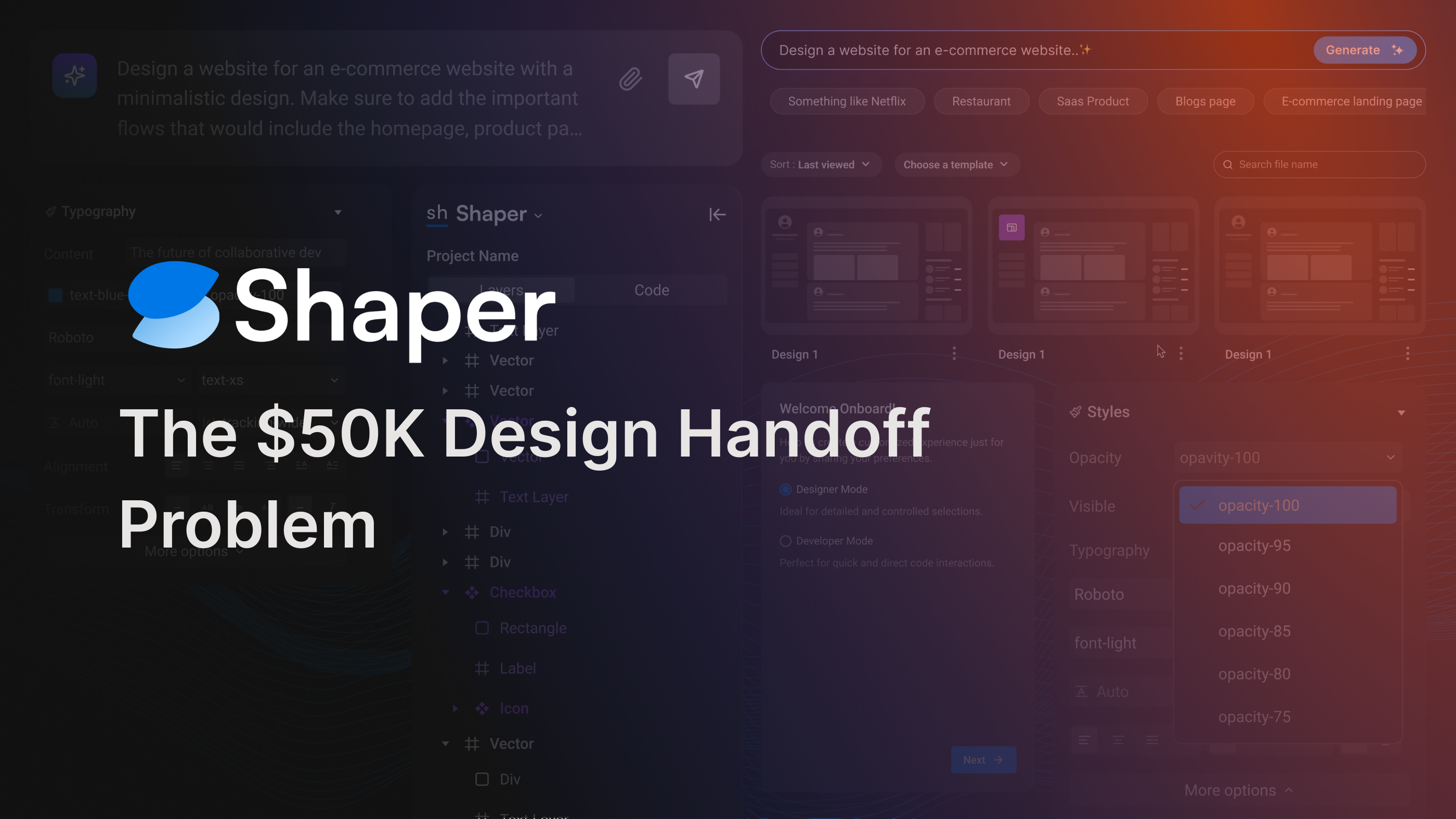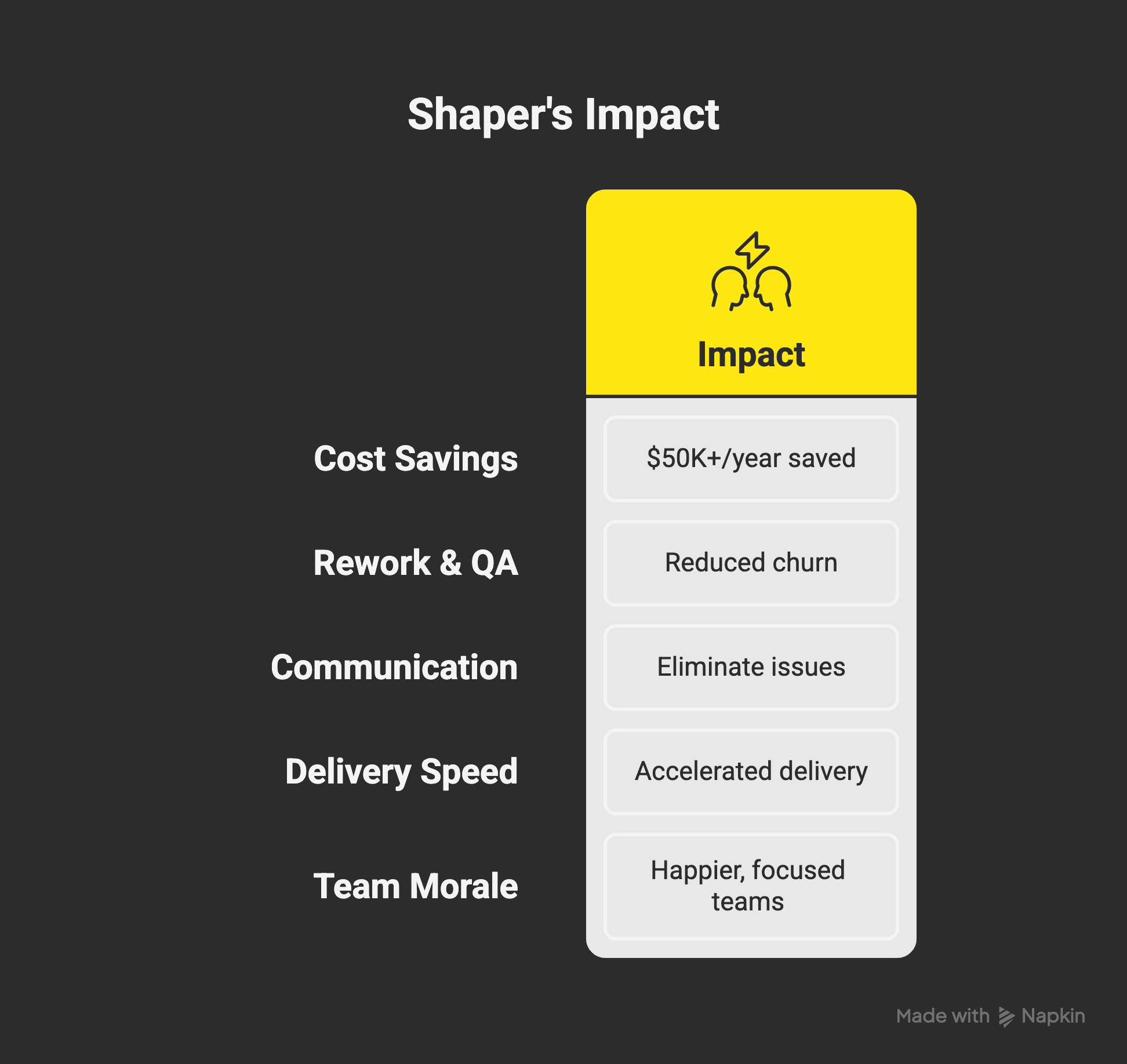The $50K Design Handoff Problem (And How We're Solving It)!
Paridhi Tulsian - June 5th, 2025

What if one of your product team’s biggest expenses was something you couldn’t find on a budget sheet? For many small and mid-size companies, the design-to-development handoff process is exactly that hidden cost. Designers craft high-fidelity mockups in tools like Figma, developers translate them into code, product managers shuffle timelines, and along the way countless hours (and dollars) vanish.
The Hidden Costs of Traditional Design Handoffs
Design handoffs aren’t just operational hiccups—they’re a measurable drain on productivity. In a 2024 DesignOps survey, two-thirds of respondents reported wasting between 25% and 50% of their work time on design delivery inefficiencies. That’s 10–20 hours per person per week spent on unproductive tasks like clarifying specs, fixing inconsistencies, and duplicating work—none of which directly contribute to product value. Framed financially, this inefficiency equates to tens of thousands of dollars in annual salary costs for small to mid-sized product teams.
So where does that time go? It turns out teams bleed hours through a thousand small cuts in the handoff process. Common culprits include:
- Pixel-fixing and QA churn: Teams burn hours identifying and correcting visual inconsistencies between designs and implementation. Minor styling errors that should’ve been aligned from the outset become cycles of back-and-forth.
- “Is this final?” confusion: Developers often hesitate due to uncertainty about design status. Without clear version ownership, they either delay work or implement outdated frames—both scenarios leading to rework.
- Fragmented stakeholder feedback: Disconnected review cycles force last-minute changes. Designers scramble to update, and developers are left racing to adjust under time pressure.
- Version control chaos: Late-stage design updates often lack traceability, resulting in teams playing detective with old and new design files. The result? Unplanned fixes and wasted dev effort.
These issues form a compounding productivity tax. If every team member loses a full day each week to handoff friction, companies are effectively funding an invisible team with no output. 66% of designers spend 4–8 hours weekly explaining their designs, and 65% of developers spend the same time interpreting them. That’s nearly a full workday per role, per week, devoted entirely to bridging a workflow gap. For a five-person product team, this adds up to over $50,000 per year in lost productivity—enough to hire additional talent, extend runway, or reinvest in growth-critical tools.
Handoff Friction Across the Team
Design handoffs don’t just waste time—they fundamentally disrupt how each function operates.
- Designers spend cycles repeating specs, answering questions, and rebuilding finalized mockups. This leads to "design drift," where what ships diverges from the design system, requiring cleanup sprints and compounding fatigue.
- Developers lose hours deciphering logic and layout decisions. When specs are vague or outdated, they resort to guesswork. The result: rework, bugs, and late-stage adjustments. Fixing UI errors during development costs 6× more, and post-launch, it can balloon to 100×
- Product Managers and the Business face shifting timelines, launch delays, and erosion of user trust. A misunderstood screen during QA can delay release by weeks. PMs spend time mediating miscommunication instead of driving strategy. According to Forrester, post-launch fixes cost 30× more than catching issues early. One DevOps report pegs unnecessary rework at $37.8M annually for mid-sized teams. For smaller ones, $50K/year in misalignment is a conservative estimate.
And then there’s morale. When designers and developers spend more time babysitting process than building, burnout sets in. Even a single resignation can stall momentum and cost thousands in onboarding and lost velocity.
A No-Handoff Future: How Shaper is Solving It
The best “handoff” is no handoff at all. That principle drives how we built Shaper—a radically different design-to-code platform where designers, developers, and product teams co-create in real time, on a shared canvas that outputs production-ready code. No silos. No translation layers. Just one unified source of truth where design is development.
Imagine this: as a designer constructs a component, it’s instantly backed by clean, usable code. No separate design file. No guesswork for devs. No lag in implementation. Designers use a visual builder. Developers interact with real components. Everyone sees the same thing—because they're building in the same place. This isn’t sequential work—it’s simultaneous collaboration.
Shaper’s No-Handoff Workflow Solves the Root Problem
Rather than layering on more process, Shaper eliminates the friction at the source. Here’s how:
- Design is code, not a suggestion. Every design decision—spacing, responsiveness, interactivity—is rendered in actual, production-grade code. Developers don’t need to interpret specs or reverse-engineer layouts.
- Real-time collaboration across functions. A designer updates a layout; a developer refines the logic; a PM tweaks copy—all in the same environment. Feedback is instant. Iterations are fast. There’s no file-sharing or “Is this final?” Slack threads.
- One system, one truth. Shaper doubles as your component library and design system manager, reducing duplication and enforcing consistency by default.
- Designed for inclusivity. Shaper balances visual control and code precision. Designers don’t need to code. Developers get the tools they need. Co-editing is seamless and respectful of each discipline.

Shaper isn’t just a tool—it’s a new way of working. Unified. Collaborative. Frictionless. Built for the future of product development.
Ready to Eliminate Handoffs? Join the Shaper Waitlist
Sticking with the status quo means continuing to lose time, money, and momentum. But that’s no longer necessary. Shaper gives you the environment to build better—together.
Join the waitlist today and be among the first to experience a truly no-handoff, real-time design-to-code workflow. It’s not a patch. It’s a paradigm shift.